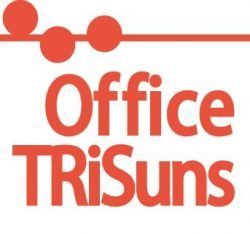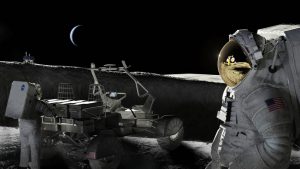Monitoring the effects of daily activities on the physiological responses of the body calls for wearable devices that can simultaneously track metabolic and haemodynamic parameters. Here we describe a non-invasive skin-worn device for the simultaneous monitoring of blood pressure and heart rate via ultrasonic transducers and of multiple biomarkers via electrochemical sensors. We optimized the integrated device so that it provides mechanical resiliency and flexibility while conforming to curved skin surfaces, and to ensure reliable sensing of glucose in interstitial fluid and of lactate, caffeine and alcohol in sweat, without crosstalk between the individual sensors. In human volunteers, the device captured physiological effects of food intake and exercise, in particular the production of glucose after food digestion, the consumption of glucose via glycolysis, and increases in blood pressure and heart rate compensating for oxygen depletion and lactate generation. Continuous and simultaneous acoustic and electrochemical sensing via integrated wearable devices should enrich the understanding of the body’s response to daily activities, and could facilitate the early prediction of abnormal physiological changes.
www.nature.com/articles/s41551-021-00685-1
An epidermal patch for the simultaneous monitoring of haemodynamic and metabolic biomarkers | Nature Biomedical Engineering
Monitoring the effects of daily activities on the physiological responses of the body calls for wearable devices that can simultaneously track metabolic and haemodynamic parameters. Here we describe a non-invasive skin-worn device for the simultaneous monitoring of blood pressure and heart rate via ultrasonic transducers and of multiple biomarkers via electrochemical sensors. We optimized the integrated device so that it provides mechanical resiliency and flexibility while conforming to curved skin surfaces, and to ensure reliable sensing of glucose in interstitial fluid and of lactate, caffeine and alcohol in sweat, without crosstalk between the individual sensors. In human volunteers, the device captured physiological effects of food intake and exercise, in particular the production of glucose after food digestion, the consumption of glucose via glycolysis, and increases in blood pressure and heart rate compensating for oxygen depletion and lactate generation. Continuous and simultaneous acoustic and electrochemical sensing via integrated wearable devices should enrich the understanding of the body’s response to daily activities, and could facilitate the early prediction of abnormal physiological changes.
www.nature.com/articles/s41551-021-00685-1
惑星系の化学組成は誕生前から多様? | 理化学研究所
国際共同研究グループは、「原始惑星系円盤[2]」が形成され始める若い天体に着目し、アルマ望遠鏡を用いて、ペルセウス座分子雲[3]に属する約50個の原始星周りのガスの化学組成を調べたところ、天体ごとのガスや塵の総量などの違いを考慮に入れても、メタノールとアセトニトリルの存在量は天体によって100倍以上異なることが分かりました。一方で、それらの分子同士の存在量比は良く相関していました。また、より複雑なギ酸メチルあるいはジメチルエーテルのメタノールに対する存在量比は、ガスの密度が高いほど高い傾向にありました。これらの結果は、同じ領域の分子雲で惑星系が誕生したとしても、異なる化学組成の惑星系となり得る可能性を示しているとともに、惑星系形成に伴う有機分子の生成・進化過程の理解の大きな手掛かりとなるものです。
www.riken.jp/press/2021/20210319_4/index.html
NASA Announces Lunar Delivery Challenge Winners | NASA
With the Artemis program, NASA will send the first woman and next man to the surface of the Moon, construct a lunar orbiting outpost, and establish a sustainable presence. This will require deliveries of supplies and equipment to the lunar surface, but how to unload the cargo once it arrives is an open question. NASA created the Lunar Delivery Challenge to seek ideas from the public for practical and cost-effective solutions to unload payloads onto the surface of the Moon.
“Seeing some of these new concepts is actually pretty eye-opening,” said Paul Kessler, an aerospace engineer at NASA’s Langley Research Center in Hampton, Virginia, and one of the judges for the challenge. “It’s brought to light some ideas that we had not considered before.”
The challenge received 224 entries before the submission period closed Jan. 19, 2021. The ideas came from various types of space enthusiasts who share a passion for human space exploration, and participants varied from student teams, to individuals from the private sector, to parent-child duos.
www.nasa.gov/feature/nasa-announces-lunar-delivery-challenge-winners
音響から楽譜へのピアノ採譜
このページは次の論文の内容に関するWebページです。 Kentaro Shibata, Eita Nakamura, Kazuyoshi Yoshii Non-local musical statistics as guides for audio-to-score piano transcription Information Sciences誌に掲載予定 [arXiv:2008.12710] データのダウンロード 論文で使ったデータをダウンロードできます データの内容についてはREADME.txt(英語)をお読みください。
audio2score.github.io/index-ja.html
Smoke & Fire! NASA Tests the World’s Most Powerful Rocket
www.youtube.com/embed/OvzeB1TI5qw?rel=0&fullscreen=0&autoplay=0&enablejsapi=1&version=3&showinfo=0&controls=0 via #NASA_APP
NASA @NASA
Ready to see the world’s most powerful rocket come alive?

Watch this recap of our @NASA_SLS’s hot fire test with all 4 of its engines firing, just as they will during the @NASAArtemis I launch to the Moon this year: youtu.be/OvzeB1TI5qw pic.twitter.com/wdUqG0HCGN
2021/03/19 9:02
【プレスリリース】東京医科大学分子病理学分野の黒田雅彦主任教授ら研究チーム 「「植物由来小胞を担体とした新規ドラッグデリバリーシステムを開発」〜核酸医薬が経口投与可能、核酸医薬品の適応性拡大に期待〜 | 東京医科大学
●アセロラ果汁からエクソソーム様小胞が低コストで安定的に供給可能であることを見出しました。
●siRNA、miRNAなどの核酸医薬をアセロラ由来小胞と混合させることにより、核酸分解酵素への耐性、および酸、アルカリ耐性が得られることを明らかにしました。
●核酸医薬とアセロラ由来小胞の混合物をマウスに経口投与し、標的臓器で核酸医薬を機能させることに成功しました。
●経口投与により、これまでより簡便で、新たな標的臓器に適応可能な核酸医薬開発への応用が期待されます。
www.tokyo-med.ac.jp/news/2021/0319_152000002634.html


